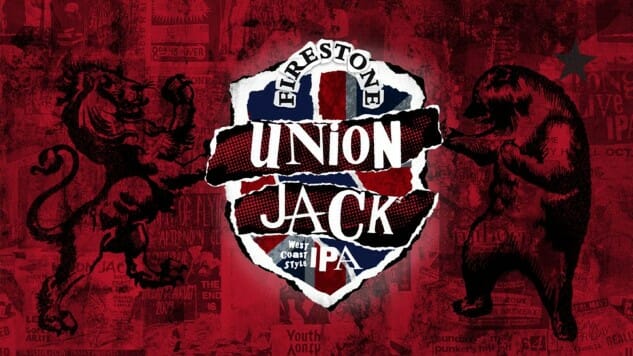My Month of Flagships: Firestone Walker Brewing Co. Union Jack IPA
Photos via Firestone Walker Brewing Co.
This essay is part of a series this month, coinciding with the concept of Flagship February, wherein we intend to revisit the flagship beers of regional craft breweries, reflect on their influence within the beer scene, and assess how those beers fit into the modern beer world. Click here to see all the other entries in the series.
Somewhere deep, long ago in the crevasses of memory, there was a time when Paste didn’t really conduct blind tastings of beer and spirits. That cursed era—you might think of it as “the before time”—came to firm end somewhere around 2012 or 2013. It’s difficult for me to say for sure, but a major watershed moment was the very first time that Paste conducted a large-scale blind tasting of American IPAs. And that was also arguably the beginning of our longstanding appreciation of Firestone Walker Brewing Co., the company we would eventually laud as the #1 overall American brewery of the 2010s.
The tasting in question was conducted in the form of a 64-seed tournament, playfully titled “Top of the Hops.” The lineup is fascinating to look at now in 2020, capturing as it did a field of well-liked American IPAs as they existed only a short while before the sea-change of juicier, hazier IPAs would begin to transform the style in the U.S. The 2013 Top of the Hops lineup, on the other hand, captures a specific moment in time when the idea of “West Coast IPA” was still king, even as some of the underlying influences that would eventually push us in the direction of hazy, juicy IPA were beginning to merge.
When the dust settled from that momentous first tournament, the winner was Firestone Walker Union Jack IPA, narrowly triumphing over Cigar City’s equally beloved Jai Alai. It was a big moment for both Firestone Walker and for Paste’s editors, setting us down a path that would eventually see us do absurd things like blind tasting 324 IPAs over the course of 17 days. It’s safe to say that we might never have gone down that road otherwise, and it’s also safe to say that our appreciation of the original winner Union Jack was never dulled, either.
Times do change, however, and even though Union Jack is one of the newer beers in this Flagship February series (it made its debut in the mid-2000s), it’s hard to overstate how much the market for IPAs has evolved even since that tournament in 2013. Indeed, the average thing labeled “IPA” today is almost unrecognizably different in its approach than the average beer labeled “IPA” seven or eight years ago, and there’s no shortage of beer geeks who would now look at a beer like Union Jack and immediately think of it as antiquated.
Looking at an outline of the beer’s recipe, which Firestone helpfully provides on their website, one can see how they would come to that conclusion. The existence of crystal malt in a modern IPA? Dry-hopping with something other than solely Citra, Mosaic and Galaxy? Sacrilege! It’s certainly not how breweries are designing their IPAs these days, but Union Jack was never meant to be an IPA that tastes like fresh fruit juice running down your chin. There’s a big citrus element there, yes, but this is a beer conceived in the days when many IPAs could still be expected to contain some element of both bitterness and refreshment. They were beers you consumed with food at a bar, rather than beers you wanted to freeze into an alcoholic slushie and drink out of a Big Gulp cup. They had, dare I say, a bit of dignity rather than the modern desire to simply activate every pleasure center of the brain via liquid sugar.